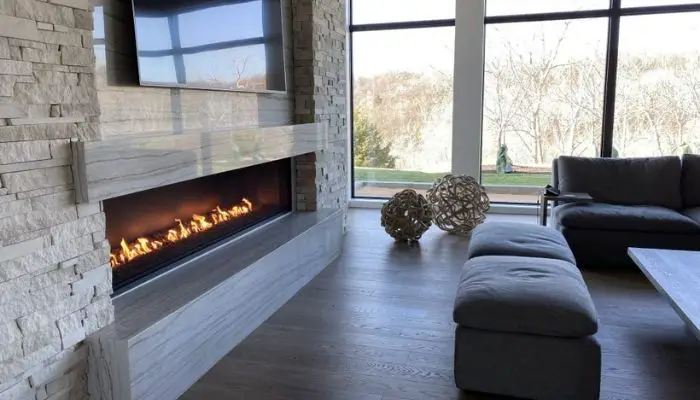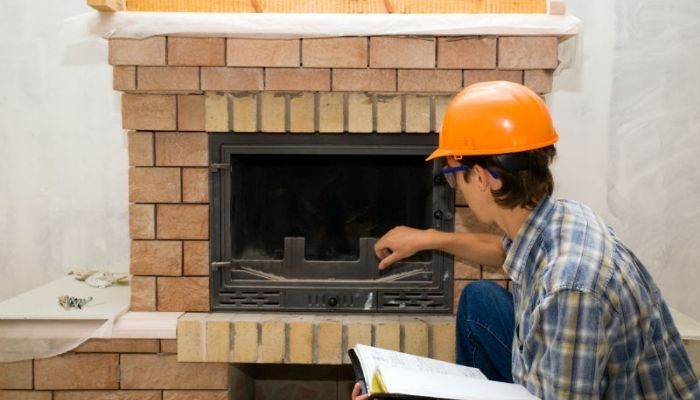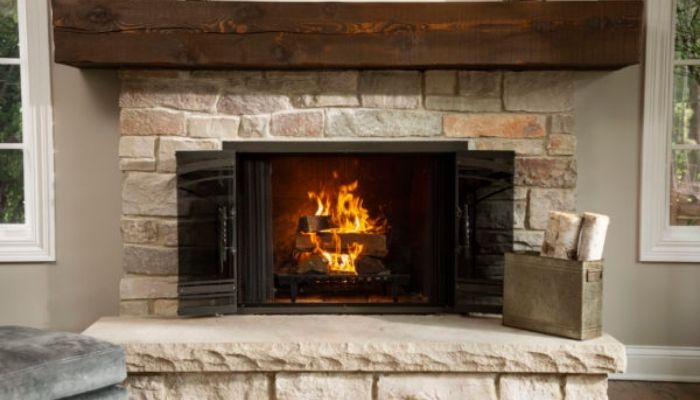Gas fireplaces burn natural gas or liquid petroleum to generate heat for the homeowners. Such fireplaces burn non-renewable fuels, but they produce fewer emissions than the traditional wood fireplace. This does not mean they are 100% safe for our environment. Leaks of natural gas and carbon monoxide degrade indoor air quality.
There are two categories of the gas fireplace; vented and ventless gas fireplace. So, which is right for you and the environment? They both have their pros and cons depending on several factors. Vented gas fireplaces prove better as they do not downgrade the indoor air quality. The emissions are released to the outside, polluting the outdoor environment. A ventless gas fireplace releases the emissions into the room, thus making it unsafe.
Wood vs. Gas Fireplaces
1. Efficiency
According to the Environmental Protection Agency (EPA), well over 12 million wood stoves and fireplaces are currently in use in American households. Around 9 million of them are obsolete and unable to meet EPA regulations. These are 50% less effective than modern systems when burning. As a result, gas fireplaces are far more ecologically friendly and efficient than their earlier wood-burning equivalents.
Research by EPA shows that replacing your outdated fireplace will reduce your wood use by two-thirds, saving you time, cash, energy, and resources.
2. Emissions
Emissions are produced by more than just your automobile; fireplaces also produce them. Although both wood and propane fireplaces emit pollutants into the atmosphere, gas systems emit far less. Natural gas fireplaces have been determined to have a considerably lower environmental effect than wood fireplaces, emitting 99 percent fewer pollutants.
Because of the significant reduction in emissions, your propane fireplace will emit less harmful pollutants inside and outside your house. It will also reduce creosote buildup in your flue, which is a very explosive result of wood burning in your fireplace, and you won’t have to worry about annoying soot or ashes anymore. The fewer the emissions, the better the efficiency is a reasonable rule of thumb.
3. Health concerns
Switching from a wood-burning to a gas-burning fireplace would reduce the carbon footprint and minimize the risk of health concerns. A gas-burning fireplace will minimize soot pollution that has been associated with cancer, asthma, and a variety of other health problems. This little modification may have a significant impact on your family’s health. Also, the risk of carbon monoxide poisoning is reduced.
Carbon Monoxide Poisoning in Gas Fireplaces
Gas fireplaces may cause carbon monoxide poisoning. While there are various possible sources of exposure, such as specific equipment and gadgets, motor vehicles, and wood fires, gas fireplaces are among the top culprits. Carbon dioxide results from the oxidation process after the full combustion of fossil fuels, including elemental carbon and hydrogen.
Incomplete combustion may occur when a gas fireplace is not adequately maintained or aired, resulting in carbon monoxide production and the danger of carbon monoxide poisoning for individuals within.
What are the indications of a likely carbon monoxide poisoning in your home? The following include the signs of such poisoning, but they are not limited;
- Nausea
- Chest Pain
- Dizziness
- Headache
- Shortness of breath
- Unconsciousness
Prolonged-release of carbon monoxide into the environment can result in chronic effects. According to the National Safety Council (NSC), the following are the results of being exposed to carbon monoxide for a long time;
- Vomiting
- Loss of Consciousness
- Loss of Muscular Coordination
- Death
- Mental Confusion
Carbon monoxide poisoning can sometimes be confused with having the flu. It is thus vital to seek medical attention when you see someone with such symptoms.
How to Reduce Effects of Gas Fireplaces on the Environment
Yes, gas fireplaces have proved to be better for the environment than wood-burning fireplaces. You can even do procedures to make them safer for the individuals. These include;
- Conducting a gas fireplace safety check. This allows you to deal with algae or any plant that may interfere with gas lines. Dirt and debris can also be cleaned, thus no deterioration of the indoor air quality. Gas leak tests are key to avoiding poor indoor air quality.
- A yearly inspection by professionals is key. This helps estimate the condition of the gas fireplace and establish whether it is harmful to your health or the environment.
- Investing in smoke and carbon monoxide detectors will help safeguard the air quality in homes. The deadly gas and smoke are detrimental to human health. Smoke is among the lead causes of acid rain.
Conclusion
Gas fireplaces are fewer pollutants to the environment compared to wood fireplaces. This, however, does not mean that they are the best option for fireplaces. They, too, can release toxic products into the environment like smoke and carbon monoxide. The tips provided can help reduce environmental pollution. There are also other alternatives to fireplaces like electric fireplaces with less or zero emissions.


